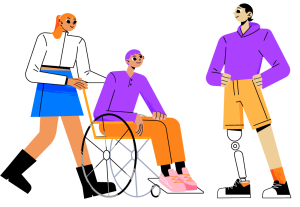Supported Independent Living (SIL) is a life-changing support that empowers people with disabilities to live independently, manage daily tasks, and thrive in their chosen living arrangements. If you or a loved one are exploring ways to live independently with the help of NDIS funding, then understanding SIL is a great place to start!
In this blog, we’ll answer all the essential questions about SIL, explain the difference between SIL and SDA, and share what to expect from this type of NDIS support. So, let’s dive in and explore how Supported Independent Living can help you live your best life!

What does SIL mean?
Supported Independent Living (SIL) is a type of funded support under the National Disability Insurance Scheme (NDIS). It’s designed to assist people living with disability or complex needs who want to live more independently. With SIL, NDIS participants receive daily living supports and personal care from trained support workers. This might include help with cooking, cleaning, personal care, and even managing finances—all tailored to the unique needs of the individual.
SIL helps people take control of their day-to-day lives, build essential skills, and achieve greater independence within their homes and communities. With supported independent living, you’re not just getting support, you’re building the confidence and skills to live the way you want!
Frequently Asked Questions about Supported Independent Living
What is SIL accommodation?
SIL accommodation refers to homes or apartments where NDIS participants live with the support of SIL services. These living options are usually shared arrangements, like group homes or shared living environments, but they can also be independent living spaces, depending on what best suits the participant’s needs.
What should you expect in a typical SIL accommodation setup?
A comfortable living environment
SIL homes are often equipped to meet accessibility needs and may include shared spaces like kitchens and lounges.
Personalised support plans
Support workers provide tailored assistance with daily tasks, ensuring each resident’s unique needs and goals are met.
Life skills development
SIL accommodation encourages residents to develop skills in areas like cooking, cleaning, and community involvement, which can be empowering and build independence.

What is a SIL house?
A type of SIL accommodation, a SIL house is a home specifically designed for Supported Independent Living. It might be shared with other residents who have similar support needs, creating a sense of community while providing privacy and individual space.
SIL houses are ideal for people who benefit from living alongside peers and having access to support around the clock. Each house is designed to create a supportive, nurturing environment where residents can gain confidence and enjoy an independent lifestyle.
What is the difference between SIL & SDA?
Understanding the difference between Supported Independent Living (SIL) and Specialist Disability Accommodation (SDA) can be confusing, so let’s break it down!
SIL (Supported Independent Living)
SIL is a support service that provides hands-on assistance to help individuals with daily activities, such as cooking, cleaning, and personal care. SIL funding covers the support workers and services provided to residents.
SDA (Specialist Disability Accommodation)
SDA, on the other hand, is a type of accommodation funding that provides physical housing modifications and specialised features for people with complex physical or sensory needs. An SDA home offers varying levels of design features to give NDIS participants the support they need. These features include ramps, wide corridors and more.
In summary, SDA funding covers the physical aspects of the residence, while SIL funding provides the ongoing support required within that environment. Some participants may be eligible for both, allowing them to live in an adapted space with the daily support they need.

How does SIL funding work?
Funding for Supported Independent Living will form part of an NDIS participant’s plan, specifically allocated to cover the costs of support workers and services that help them live independently.
The amount of SIL funding a participant receives depends on their unique support needs, as outlined in their NDIS plan.
SIL funding is separate from SDA or other NDIS supports, and it is only available to participants who require significant assistance with daily living. The level of SIL support is determined after an assessment, usually with the help of a support coordinator, to ensure that the participant receives the appropriate level of care.
Who is eligible for SIL support?
SIL support is designed for NDIS participants who need daily, ongoing assistance to live independently. It’s ideal for those who might struggle to manage personal care, household tasks, and daily routines without help.
To determine eligibility, an NDIS planner or support coordinator assesses the participant’s level of independence and day-to-day needs. Supported Independent Living is generally for people with medium-to-high support needs, as it focuses on providing consistent, reliable assistance for daily living.
What types of support are provided in SIL?
In SIL, support varies depending on the individual’s needs and goals, but common types of support include:
Personal care
Assistance with bathing, dressing, grooming, and medication.
Daily living support
Help with household chores like cooking, cleaning, and laundry.
Skill-building
Opportunities to develop life skills like managing money, shopping, or using public transport.
Community engagement
Support with social activities and participation in community events to help residents feel connected and engaged.
How to choose the right SIL provider
Choosing the right SIL provider is essential to ensure the best quality of care and support. Here are some tips to keep in mind:
Experience and expertise
Look for providers with experience in delivering quality support and have a strong understanding of NDIS requirements.
Trained support workers
Make sure support workers are qualified, compassionate, and aligned with the participant’s needs.
Personalised approach
A good SIL provider will take the time to understand an individual’s goals, preferences, and daily needs.
Positive environment
Choose a provider that fosters a supportive, inclusive, and welcoming environment.
We’re biased when it comes to choosing SIL providers. However, here at The SIL Company, we’ve got a strong track record of delivering quality care and helping participants to reach their goals. Find out more about how we’re making a difference in delivering quality care.
How does SIL impact daily living and independence?
SIL has a positive impact on daily living by providing support where it’s needed most, allowing participants to live more independently while enjoying a safe, supportive environment. With SIL, people can gain confidence, develop skills, and take control of their lives—step by step.
What are the benefits of SIL?
Supported Independent Living offers numerous benefits for NDIS participants, such as:
Increased independence
By assisting with daily tasks, SIL enables participants to live more independently.
Skill-building opportunities
Residents can develop essential life skills to help them achieve their goals.
Social engagement
Living in SIL accommodation often means being part of a community and participating in social activities.
Peace of mind for families
Knowing their loved ones are receiving quality care and support brings families peace of mind.
Supported Independent Living (SIL) can be a transformative experience for NDIS participants who want to live more independently while receiving the right level of support. From daily living assistance to skill-building opportunities, SIL is designed to help you live life on your terms.
If you’re considering Supported Independent Living, reach out to our team today and let’s discuss your (or your loved one’s) needs and options.




